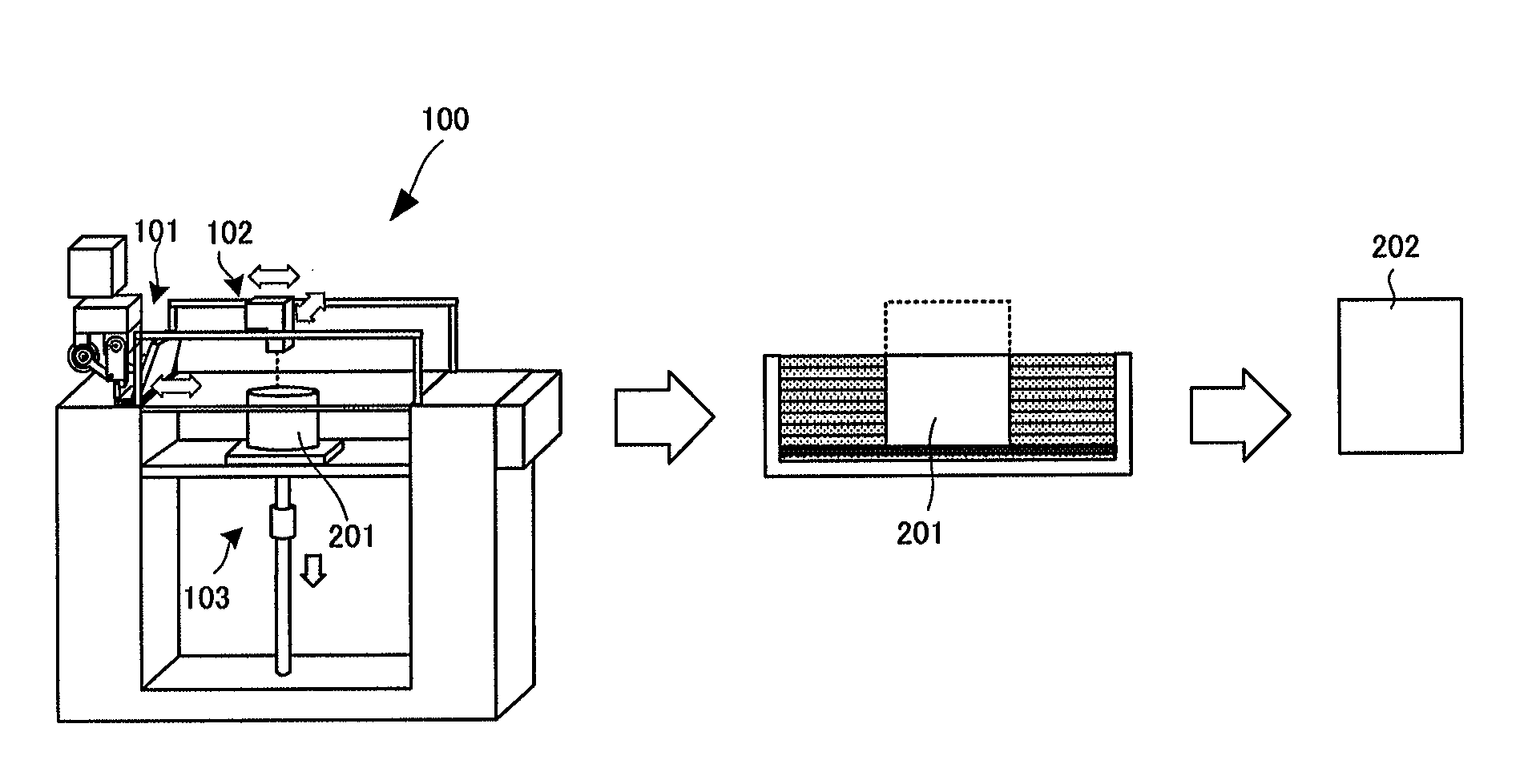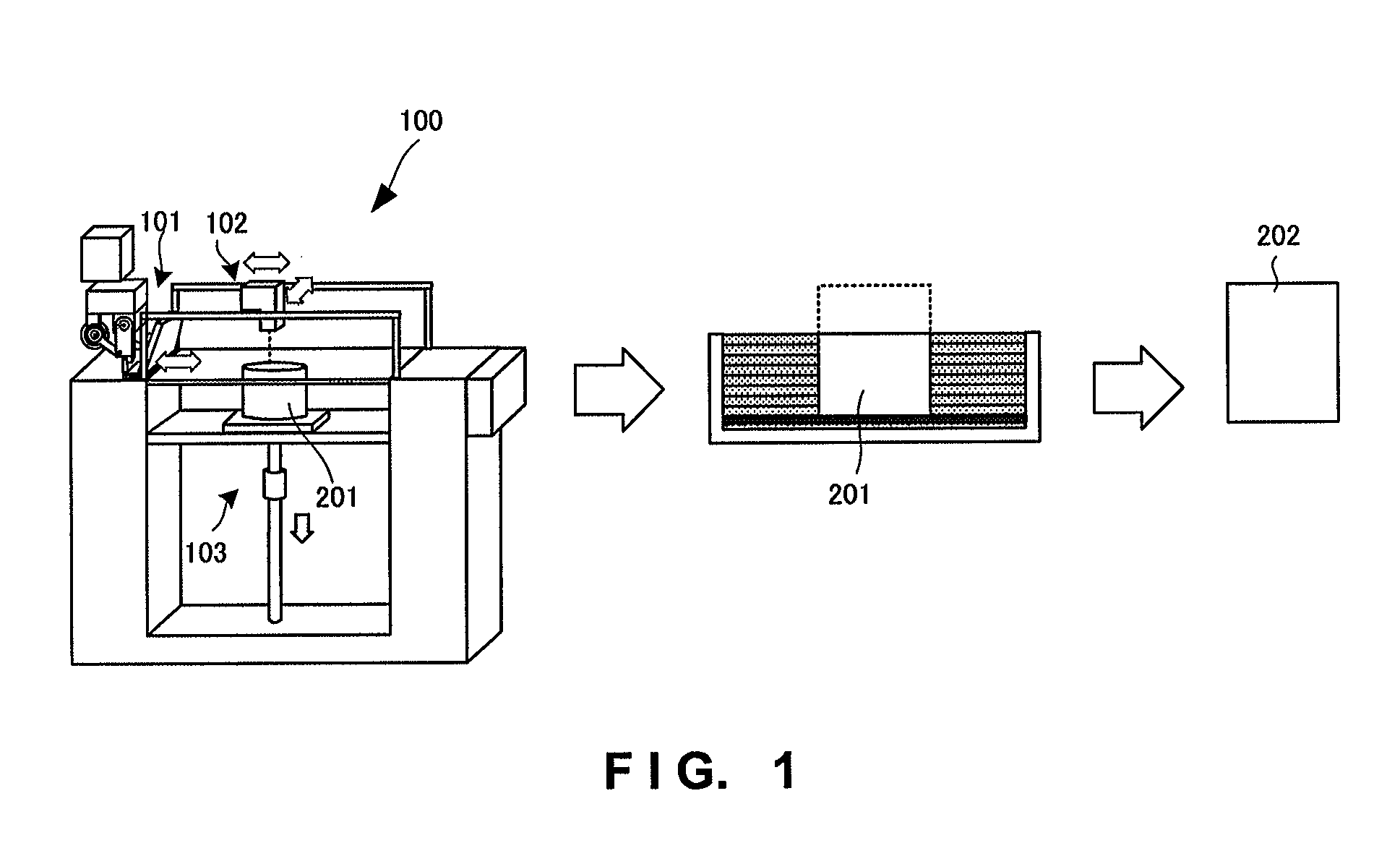Granular material, three-dimensional lamination-shaped mold manufacturing apparatus, and three-dimensional lamination-shaped mold manufacturing method
a three-dimensional lamination and mold technology, applied in the direction of manufacturing tools, foundry moulding equipment, foundry patterns, etc., can solve the problems of increasing the number of models, unable to manufacture molds, and complicating the process
- Summary
- Abstract
- Description
- Claims
- Application Information
AI Technical Summary
Benefits of technology
Problems solved by technology
Method used
Image
Examples
examples
[0061]Examples of the present invention will be explained in more detail below, but the present invention is not limited to these examples. Note that a water-soluble ester and coating sand used in these examples will be presented below, and methods of measuring the thermal expansion coefficient and generated gas component of a test piece obtained by each example will be presented below.
[0062](Water-Soluble Ester)
[0063]An aqueous ester solution was prepared by mixing 50 pts.mass of triethylene glycol diacetate and 50 pts.mass of water.
[0064](Coating Sand)
[0065]A refractory granular material was heated to 110° C. by a sand heater. 3.0 pts.mass of water glass (molar ratio (SiO2 / Na2O:2.50, Baumé degree: 50 (20° C.)) were added to 100 pts.mass of the heated refractory granular material, and water as a solvent was volatilized by stirring the material for 5 min. After that, the material was cooled to room temperature (25° C.), and passed through a sieve having an opening of 0.6 mm, thereby...
examples 1 & 2
Example 1
[0073]Water-glass-coated coating sand was prepared by using silica sand (FS001-EU distributed by EX ONE, average grain size=106 μm) as a refractory granular material.
[0074]This coating sand was laminated on the bottom surface of a metal case placed in a three-dimensional laminating apparatus (manufactured by CMET) using a printing shaping method, by a blade mechanism including a recoater.
[0075]Then, a printing nozzle head was scanned on the laminated coating sand based on data obtained by 3DCAD design of the shape of a three-dimensional lamination-shaped mold, thereby printing an aqueous ester solution such that the discharge amount was 1.2 pts.mass with respect to 100 pts.mass of the laminated sand. After the aqueous ester solution was printed, the bottom surface (a shaping table) of the metal case was moved down by one layer (280 μm), the coating sand was laminated in the same manner as above, and the aqueous ester solution was printed on it. By repeating this process inc...
example 2
[0080]Test pieces were manufactured and evaluated following the same procedures as in Example 1, except that artificial sand (CERABEADS X #1450 manufactured by ITOCHU CERATECH, average grain size=106 μm) obtained by a sintering method was used as the refractory granular material. Table 1 shows the evaluation results of Example 2.
[0081]Also, the refractory granular material in an aqueous ester solution unprinted portion was not regenerated but reused as reusable sand.
PUM
| Property | Measurement | Unit |
|---|---|---|
| Fraction | aaaaa | aaaaa |
| Water content | aaaaa | aaaaa |
| Solubility (mass) | aaaaa | aaaaa |
Abstract
Description
Claims
Application Information
 Login to View More
Login to View More - R&D
- Intellectual Property
- Life Sciences
- Materials
- Tech Scout
- Unparalleled Data Quality
- Higher Quality Content
- 60% Fewer Hallucinations
Browse by: Latest US Patents, China's latest patents, Technical Efficacy Thesaurus, Application Domain, Technology Topic, Popular Technical Reports.
© 2025 PatSnap. All rights reserved.Legal|Privacy policy|Modern Slavery Act Transparency Statement|Sitemap|About US| Contact US: help@patsnap.com



